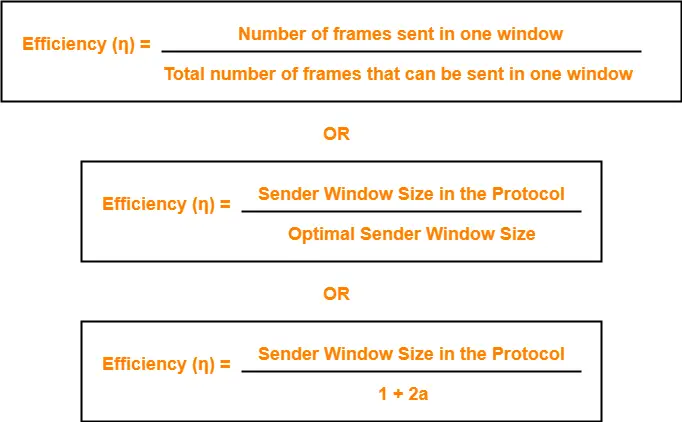Selective Repeat Protocol-
Before you go through this article, make sure that you have gone through the previous article on Selective Repeat Protocol.
We have discussed-
- Sliding Window Protocols allow the sender to send multiple frames before needing acknowledgements.
- Selective Repeat is an implementation of a sliding window protocol.
In this article, we will discuss practice problems based on selective repeat protocol.
PRACTICE PROBLEMS BASED ON SELECTIVE REPEAT PROTOCOL-
Problem-01:
The maximum window size for data transmission using the selective repeat protocol with n bit frame sequence numbers is-
- 2n
- 2n-1
- 2n-1
- 2n-2
Solution-
We know-
- With n bits, total number of sequence numbers possible = 2n.
- In SR Protocol, sender window size = receiver window size = W (say)
For any sliding window protocol to work without any problems,
| Min Available Sequence Numbers
= Sender window size + Receiver window size |
So, we have-
2n = W + W
2n = 2W
W = 2n-1
Therefore, maximum window size possible of sender and receiver = 2n-1
Thus, Option (B) is correct.
Problem-02:
In SR protocol, suppose frames through 0 to 4 have been transmitted. Now, imagine that 0 times out, 5 (a new frame) is transmitted, 1 times out, 2 times out and 6 (another new frame) is transmitted.
At this point, what will be the outstanding packets in sender’s window?
- 341526
- 3405126
- 0123456
- 654321
Solution-
In SR Protocol, only the required frame is retransmitted and not the entire window.
Step-01:
Frames through 0 to 4 have been transmitted-
4 , 3 , 2 , 1 , 0
Step-02:
0 times out. So, sender retransmits it-
0 , 4 , 3 , 2 , 1
Step-03:
5 (a new frame) is transmitted-
5 , 0 , 4 , 3 , 2 , 1
Step-04:
1 times out. So, sender retransmits it-
1 , 5 , 0 , 4 , 3 , 2
Step-05:
2 times out. So, sender retransmits it-
2 , 1 , 5 , 0 , 4 , 3
Step-06:
6 (another new frame) is transmitted-
6 , 2 , 1 , 5 , 0 , 4 , 3
Thus, Option (B) is correct.
Problem-03:
The selective repeat protocol is similar to Go back N except in the following way-
- Frame Formats are similar in both the protocols
- The sender has a window defining maximum number of outstanding frames in both the protocols
- Both uses piggybacked acknowledgements where possible and does not acknowledge every frame explicitly.
- Both uses piggyback approach that acknowledges the most recently received frame
Solution-
Also Read- Go back N Protocol
Option (A)-
- Both the protocols use the same frame formats because both are sliding window protocols.
- The variation occurs only in the coding and implementation.
Option (B)-
- In both the protocols, sender has a window which defines the maximum number of outstanding frames.
Option (C)-
- Both the protocols use piggybacked acknowledgements wherever possible.
- Sending acknowledgements along with the data are called as piggybacked acknowledgements.
- But Go back N protocol uses cumulative acknowledgements and does not acknowledge every frame explicitly.
- On the other hand, Selective repeat protocol acknowledges each frame independently.
Option (D)-
- Both the protocols use piggyback approach.
- Go back N acknowledges the most recently received frame by sending a cumulative acknowledgement which includes the acknowledgement for previous packets too if any.
- On the other hand, Selective Repeat protocol acknowledges all the frames independently and not only the recently received frame.
Thus, Options (C) and (D) are correct.
Problem-04:
Consider a 128 x 103 bits/sec satellited communication link with one way propagation delay of 150 msec. Selective Retransmission (repeat) protocol is used on this link to send data with a frame size of 1 KB. Neglect the transmission time of acknowledgement. The minimum number of bits required for the sequence number field to achieve 100% utilization is ________ .
Solution-
Given-
- Bandwidth = 128 x 103 bits/sec
- Propagation delay (Tp) = 150 msec
- Frame size = 1 KB
Now,
- To achieve 100% utilization, efficiency must be 100%.
- Efficiency is 100% when sender window size is optimal i.e. 1+2a
Calculating Transmission Delay-
Transmission delay (Tt)
= Frame size / Bandwidth
= 1 KB / (128 x 103 bits per sec)
= (1 x 210 x 8 bits) / (128 x 103 bits per sec)
= 64 msec
Calculating Value of ‘a’-
a = Tp / Tt
a = 150 msec / 64 msec
a = 2.34
Calculating Optimal Sender Window Size-
Optimal sender window size
= 1 + 2a
= 1 + 2 x 2.34
= ⌈5.68⌉
= 6
Calculating Number Of Sequence Numbers Required-
In SR Protocol, sender window size and receiver window size are same.
So, sender window size = receiver window size = 6
Now,
For any sliding window protocol, minimum number of sequence numbers required
= Sender window size + Receiver window size
= 6 + 6
= 12
Calculating Bits Required in Sequence Number Field-
To have 12 sequence numbers,
Minimum number of bits required in sequence number field
= ⌈log2(12)⌉
= 4
Thus,
- Minimum number of bits required in sequence number field = 4
- With 4 bits, number of sequence numbers possible = 16
- We use only 12 sequence numbers and rest 4 remains unused.
Next Article- Comparison Table Of Sliding Window Protocols
Get more notes and other study material of Computer Networks.
Watch video lectures by visiting our YouTube channel LearnVidFun.

